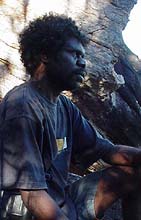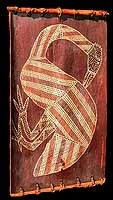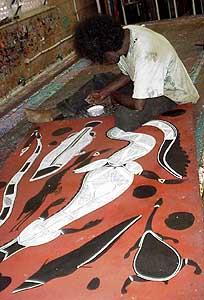|
 With no written language, Aboriginal cultures have
maintained their customs, myths, and legends through ceremony and a
deeply seated verbal tradition. Tribal lore is passed on by
storytelling, and important stories are memorized and handed down to new
generations by clan elders. As young men mature and gain prestige within
their clan, they are entrusted with specific tales known as “dreamings”,
and are considered to be the guardian of these stories until they pass
them on to the next generation. This holds true for artwork as well.
Artists “inherit” stories, themes, and characters from their tribal
group, which can be illustrated by no-one else. These inherited
characters and stories strongly influence an artist’s work, and are
repeated and embellished throughout the artist’s life. With no written language, Aboriginal cultures have
maintained their customs, myths, and legends through ceremony and a
deeply seated verbal tradition. Tribal lore is passed on by
storytelling, and important stories are memorized and handed down to new
generations by clan elders. As young men mature and gain prestige within
their clan, they are entrusted with specific tales known as “dreamings”,
and are considered to be the guardian of these stories until they pass
them on to the next generation. This holds true for artwork as well.
Artists “inherit” stories, themes, and characters from their tribal
group, which can be illustrated by no-one else. These inherited
characters and stories strongly influence an artist’s work, and are
repeated and embellished throughout the artist’s life.
|
|
 As
well as painting on stone, Aboriginal artists also painted on Eucalyptus
bark, dried and flattened over an open fire. This tradition began before
the European settlement of Australia in the 1700s. Due to their
temporary nature, most early works have been destroyed by age and
weather, and the date the style began is unknown. Painting on bark may
have begun with Aboriginal artists painting the interiors of their bark
shelters in a manner similar to painting in caves, or with the painting
of shields, weapons, and other personal objects. The use of flattened
bark increased in the 1920s with requests from outsiders for work that
could be easily transported. This technique worked, but the bark
paintings often warp or crack from drying and stress. As
well as painting on stone, Aboriginal artists also painted on Eucalyptus
bark, dried and flattened over an open fire. This tradition began before
the European settlement of Australia in the 1700s. Due to their
temporary nature, most early works have been destroyed by age and
weather, and the date the style began is unknown. Painting on bark may
have begun with Aboriginal artists painting the interiors of their bark
shelters in a manner similar to painting in caves, or with the painting
of shields, weapons, and other personal objects. The use of flattened
bark increased in the 1920s with requests from outsiders for work that
could be easily transported. This technique worked, but the bark
paintings often warp or crack from drying and stress.
|
|
Since the 1960s the introduction of oil and acrylic
paints, canvas, printmaking techniques, and high quality papers has
caused a revolution in Aboriginal art, providing Aboriginal artists with
powerful tools to visualize their rich culture and tradition. In 1990
high quality rag paper and archival watercolors were introduced to
artists working at Injalak. The paper was quickly accepted as an
alternative to painting on bark, and a technique was developed using
watercolors to create rich, layered backgrounds. Despite the
availability of modern materials, artists chose to continue to use
traditional ochre pigments to create the detailed drawings that are the
focal point of each piece.
|
|
 The
new materials introduced at Injalak were part of an attempt to create a
visual record of rapidly disappearing Aboriginal traditions. The
European colonization of Australia that began with the exile of English
prisoners in the 1700s, decimated the indigenous population through
warfare, forced enculturation, and disease, and reduced the population
from an estimated 3 million in 1700 to a quarter of a million today.
Modern Australian culture continues to change Aboriginal life, with many
young people leaving their clans and traditional lands to find work in
the cities. As a result many “dreamings” are in danger of being lost
forever. Organizations like the Injalak Art Center are working hard to
enable Aboriginal artists to take pride in their heritage, to recognize
the value of their culture, and to preserve one of the world’s oldest
and most unique artistic traditions. The
new materials introduced at Injalak were part of an attempt to create a
visual record of rapidly disappearing Aboriginal traditions. The
European colonization of Australia that began with the exile of English
prisoners in the 1700s, decimated the indigenous population through
warfare, forced enculturation, and disease, and reduced the population
from an estimated 3 million in 1700 to a quarter of a million today.
Modern Australian culture continues to change Aboriginal life, with many
young people leaving their clans and traditional lands to find work in
the cities. As a result many “dreamings” are in danger of being lost
forever. Organizations like the Injalak Art Center are working hard to
enable Aboriginal artists to take pride in their heritage, to recognize
the value of their culture, and to preserve one of the world’s oldest
and most unique artistic traditions.
While in Oenpelli, Bock and Garland acquired a
select grouping of original works from the artists working at Injalak.
These works, along with original photography documenting their journey
and the ancient rock art of the region, are available for viewing at the
Williams Gallery West in Oakhurst. |
|
CLICK
HERE To
return to page 1 |
CLICK
HERE To
view our catalog of Aboriginal Art |
![]()